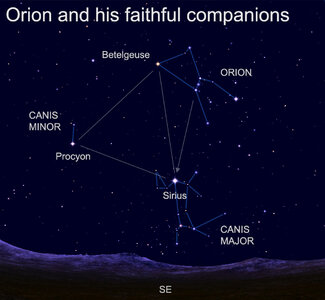Orion's Faithful Companions
Last updated 2/15/2024 at 12:32pm

I hope you get the chance to see these stars in a clear sky after what has been a rainy January in much of the country.
If your January sky has been as cloudy as mine, you might say your recent stargazing efforts have just gone to the dogs. And you'd be right!
Hopefully your sky is clear this week, because you can go out to seek two canine constellations now appearing after dark. These represent the faithful hunting dogs of Orion, the hunter, who now stands prominently in the southern sky after dark.
Orion is easily the brightest star grouping in the heavens. It's marked by a large rectangle of bright stars that supposedly outline the hunter's shoulders and knees and three equally bright stars across his middle that represent his belt. If you're struggling to find a big, strapping hunter in the sky, you may find it easier recognizing this group of stars as an hourglass, a butterfly or perhaps a bowtie.
In Greek mythology, however, Orion represents a hunter. His two hunting dogs, known as Canis Major and Canis Minor, can be found quite easily because each is marked by a single bright star. The bright star Sirius marks the constellation of Canis Major, the great hunting dog at Orion's feet. Procyon (pronounced PRO-see-yahn) marks the smaller hunting dog following closely behind.
Finding these two stars is easy, even with the waxing moon in the sky this week. Locating the fainter stars of their respective constellations, however, may be a bit of a challenge. But we can use Orion, the brightest star grouping in all the heavens, to track them down.
To locate Sirius, follow an imaginary line downward from Orion's belt, the three stars that cross the hunter's midsection. This is the star Sirius, the most brilliant of all stars in the nighttime sky, and one of the nearest as well. Sirius lies only about 51 trillion miles, or 8.6 light-years, from us. In other words, the light we see tonight from this star has been journeying in our direction since the summer of 2015.
You can imagine sparkling Sirius as a diamond in the collar of the dog who appears to be standing on his hind legs while looking up at Orion. Finding its faint stars with moonlight this week could be nearly impossible.
Canis Minor following close behind is another interesting group of stars. I use the word "group" loosely, since this constellation consists of a total of two stars here. Two! Perhaps it's a dachshund, or maybe just a hot dog. Either way, Canis Minor has to be about the easiest constellation to identify!
Its bright star Procyon forms a nearly equilateral triangle with Sirius and Orion's reddish-orange Betelgeuse. Along with Sirius, Procyon is one of the nearest stars to Earth. At a distance of about 11.5 light-years, the light we see tonight left that star on its journey toward us during the autumn of 2012.
If you love dogs as much as I do, I hope you'll take some time this week to go outdoors and search for Orion's two stellar companions. Of course, there is a third canine constellation in the heavens (Canes Venatici), but we won't be able to see it until springtime.
Visit Dennis Mammana at dennismammana.com.



